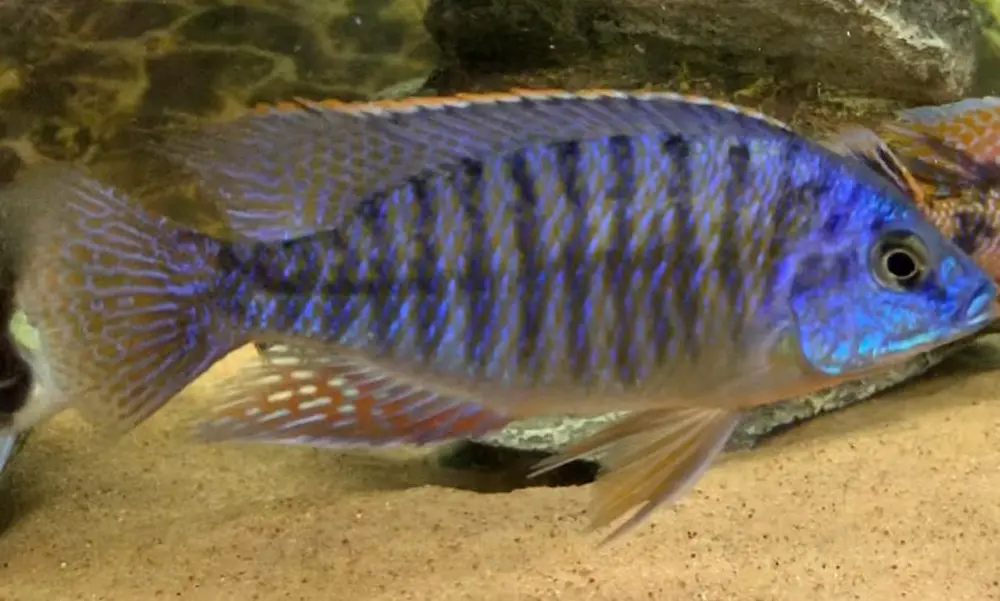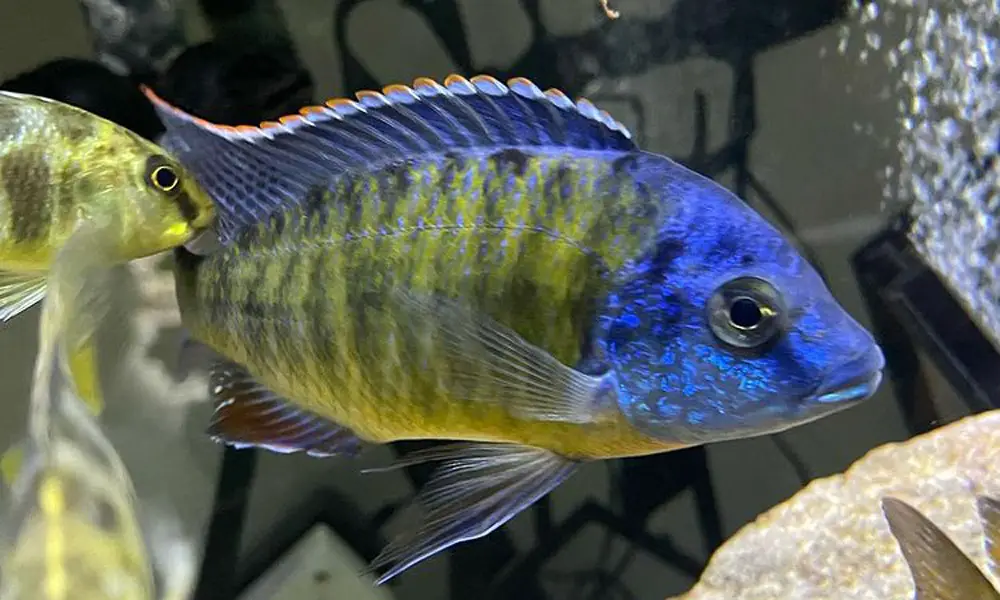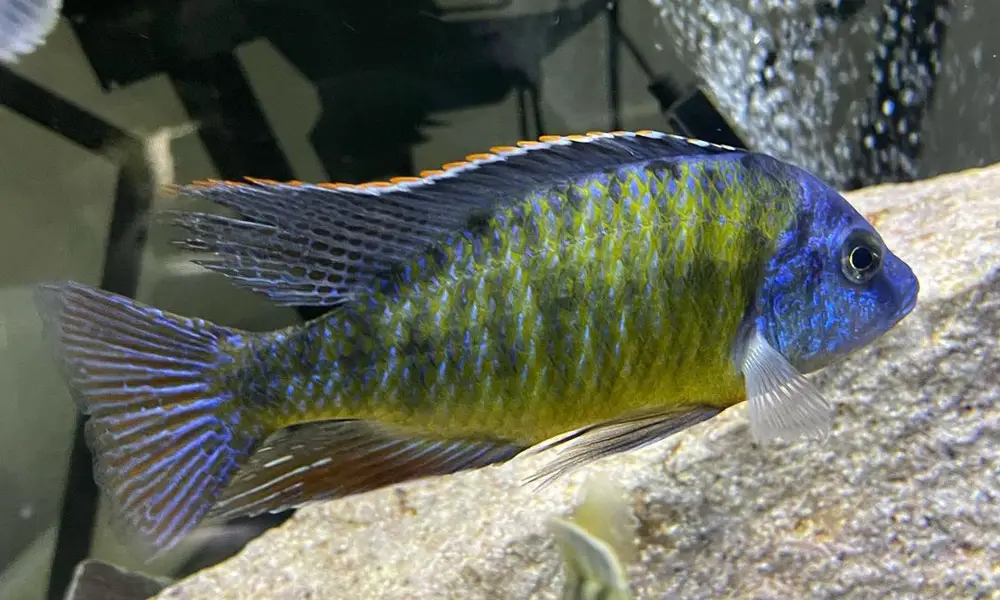Widely known for its awe-striking beauty and decent size, Tangerine Tiger Cichlid is one of the worthy additions to your aquarium. The dazzling colors and beautiful patterns make them truly eye-catching.
In addition, these species are mildly aggressive, making them a suitable choice for intermediate and advanced aquarists. Keep them with ideal tank mates and offer them accurate water conditions to make them happy and comfortable in their new home.
Planning to make a new addition? We have compiled a detailed guide that entails everything you should know about this cichlid care.
Species Summary
Being the most well-known variety of Red Empress cichlid, the Tangerine tiger cichlid earned its name due to its “Tangerine” color morphs.
Like many other Lake Malawi Cichlids, the Red Empress Cichlid (Protomelas taeniolatus) is an endemic species that has several color variations. They are named after the places they are found in Lake Malawi, including:
- Protomelas taeniolatus “likoma Is”
- Protomelas Taeniolatus “fire blue”
- Protomelas Taeniolatus “Chizumulu Is”
- Protomelas Taeniolatus “Namalenje Is”
- Protomelas taeniolatus “Chilumba Jetty”
The Tangerine tiger cichlid is scientifically known as Protomelas taeniolatus “likoma Is.”, which means it’s found in the waters around the larger Likoma Island, located on the eastern shore of the lake.
While most large Haps are known for exhibiting aggressive behavior, Tangerine tiger cichlids are fairly peaceful. They are perfect for aquarists who want to keep a large, beautiful, and docile fish in their aquarium.
| Scientific Name: | Protomelas taeniolatus “likoma Is.” |
| Common Name: | Tangerine Tiger Cichlid |
| Origin: | Lake Malawi |
| Aggressiveness: | Aggressive |
| Max Size: | 8 to 9 inches |
| Lifespan: | 5 years |
| pH: | 7.5 to 8.4 |
| Temperature: | 74 to 82F |
| KH: | 5 to 15 dGH |
| Tank Size: | Minimum: 75 Gallons | Optimal: 125 Gallons |
| Diet: | Herbivorous |
Appearance

Protomelas species are sexually dimorphic, and you can easily differentiate between genders.
Males are usually famous among fishkeepers for their dazzling adult colors, the P. taeniolatus “likoma Is” is no different.
However, the males are not as spectacular as other variations. They have a typical blue head with a base coloration of faded blue. On top of that, you’ll see a series of 7 or 8 vertical darker faded stripes that covers the base of their entire body. Unlike other Protomelas species, these stripes are still visible at the time of maturity.
This variety gets its common name, “Tangerine Tiger,” from the defining characteristics of faded yellow dots and dashes on the dorsal and anal fins as well as the vertical yellow “band” behind the head. Sometimes, their anal fin tends to have a brighter red-orange coloration.
On the other hand, females generally don’t have the identical coloration as males, making them a less preferable choice. They feature a silverish-grey color, along with the same faded black vertical stripes. An interesting note on female Tangerine tiger cichlids is a tilted dark line that runs across its eyes, from the forehead to the back of the mouth.
Generally, those bright colors and strips show up when they reach about 3 – 4 inches. It depends on the quality of food and cares you provide. If you want to bring out the colors in your Tangerine tiger cichlids, we recommend offering them a healthy diet and providing them with good water conditions.
Tangerine Tiger Cichlid Size
This fish is one of the larger species of Halochromis.
Tangerine Tiger Cichlids can grow up to 8 to 9 inches in captivity. However, in some instances, male tiger cichlids can reach up to 12 inches in the wild. But it is rarely common in the aquarium environment. Also, females tend to be smaller than males.
Male Tangerine Tiger Cichlids typically reach sexual maturity at 8 to 9 months. At this point, their colors and patterns become more vivid and pronounced. They will continue growing until they reach their full potential size in 1.5 – 2 years.
Lifespan
The average lifespan of Tangerine tiger cichlids is 5 years when in captivity. However, with proper care, they can live 7 to 10 years.
Like any freshwater fish, many factors contribute to the Tangerine tiger cichlids’ longevity, such as diet and water conditions. So, if you want your fish to have a long and happy life, be sure to provide them with the best possible care.
Tangerine Tiger Cichlid Care

The P. taeniolatus is endemic to Lake Malawi and live in relatively sediment-free substrata and rocky habitats in shallow waters where they feed on “aufwuchs” that are attached to rocks.
Caring for Tangerine Tiger Cichlid isn’t as challenging as it may seem. Although they are a bit notorious for their semi-aggressive behavior, you can still easily handle them as long as they provide them with identical tank conditions.
Always offer them optimal care if you genuinely want these cichlids to thrive in your aquarium. Here are some essential care guidelines to follow.
Tank Size
Because of their large size, a minimum aquarium of 75 gallons (48″ x 18″ x 21″) is required for a single adult Tangerine tiger cichlid.
This is the bare minimum, so we highly recommend an optimal 125-gallon (72″ x 18″ x 21″) fish tank or larger to provide these fish with plenty of space to swim and explore.
However, if you want to keep more than one Tangerine tiger cichlid in your tank, then go for a tank with 180-gallon (72″ x 24″ x 25″) or more. The large tank will help maximize its growth rate and lifespan.
They are avid swimmers and require ample room to grow. Hence, it is recommended not to compromise with the tank size to avoid future hassle.
Water Parameters
Malawi Cichlids are beautiful fish known for their bright colors and patterns. However, these fish are also quite delicate, and they will quickly deteriorate under poor water conditions.
The water in their natural habitat is extremely clear and clean with high mineral content. In captivity, these fish must be kept in water that closely mimics their natural environment. This means that the water must be well-filtered and heavily conditioned with minerals.
It is essential to stick to the ideal water parameters when keeping these cichlids in the aquarium. They do fine in hard and slightly alkaline water; hence, the water can be conditioned ideally by blending Cichlid Lake Salts that are designed to recreate the natural environment of Rift Lake African Cichlids.
- Non acidic. Manufactured in United States
- Will not impact Ph
- Will not impact skimmers
Moreover, you should avoid changing water chemistry much often as they hail from the third largest and second deepest lake in Africa, which has remarkably consistent water parameters.
- pH: 7.5 to 8.4
- Water Temperature: 74 to 82F
- Hardness: 5 to 15 dGH
- Ammonia: 0 ppm
- Nitrite: 0 ppm
- Nitrate: <10 ppm
Depending on your bio load, water changes of 20-30% weekly are recommended to maintain the appropriate water condition and to prevent deteriorating quality. Larger water changes frequently will stress fish, which is often the root cause of Malawi Bloat.
In addition, Tangerine tiger cichlids prefer plenty of water movement. Therefore, you should install a good quality filter with a high flow rate in the tank. This will help keep the water well-oxygenated and also remove the unwanted toxins from the water.
Having a sump filter is also a great option as it will provide extra space for other equipment like heaters, skimmers, etc.
Decor (Plant and substrate)
A soft sand substrate is best for Tangerine tiger cichlids as they love to sift through the sand looking for meaty protein. Also, make sure your filter system has covered with a sponge over it.
Plenty of rocks and driftwood should be provided in the aquarium as hiding places and territory. The trick is to use rocks to create many crevices by building sturdy structures vertically that stretch from the bottom to near the surface. Of course, a smooth flat rock is necessary for spawning.
These fish also love to nibble on plants but are not big diggers, so make sure you use robust plants that can withstand their chewing.
Food
- New Life Spectrum is made from quality natural ingredients
- Extreme Color enhancement and vitality in your fish
- Made in the USA
Tangerine tiger cichlids are primarily herbivorous cichlid. In the wild, they feed on ‘aufwuchs’ present in the pockets and sift through the sand looking for small invertebrates.
In captivity, these species prefer food rich in vegetable matter. You can feed them with pellets and flakes with plenty of spirulina algae and other plant-based ingredients as the base diet to keep them healthy and active.
You can also give them vegetables like lettuce, broccoli, peas, and cucumber as part of their diet. These vegetables should be finely chopped and washed to make them easier to digest.
Protein-rich food like frozen Mysis and krill can be fed periodically.
Avoid overfeeding as it can lead to health problems like obesity and Malawi bloat. Feed them 2-3 times a day in small quantities that they can consume within a few minutes.
Tangerine Tiger Cichlid Tank Mates
The Tangerine Tiger Cichlid is best kept in small groups of one male with several females in species-only tanks. Female Tangerine Cichlids are relatively peaceful even when brooding. Don’t keep two males together as they will fight for dominance unless you have a very large tank is over 200 gallons.
While Tangerine tiger cichlids are not known to be overly aggressive, they can be quite territorial when it comes to their own kind and will often establish a hierarchy within the group. That means they are not considered to be community fish.
When this fish is maintained with other Malawi Cichlids in the same tank, you need to make sure that they are of similar size and temperament. On the other hand, this fish can spawn with other closely related Protomelas species, so if you don’t want any hybridization, select species that look very different.
Here are some possible tank mates for the Tangerine tiger cichlid.
- Redfin hap (Copadichromis borleyi)
- Lethrinops Mbasi ( Lethrinops sp. “Mbasi Creek”)
- Lethrinops albus “Kande Island”
- Mdoka White Lips (Placidochromis phenochilus)
- Red Top Lwanda Peacock Chiclid (Aulonocara sp. Lwanda)
Breeding
These African cichlids are mouthbrooders. After spawning, they carry the eggs and fries in their mouths to protect them from external threats.
To spawn them in the aquarium, you should place one male with several females so that that male can initiate the breeding process. The spawning process of this cichlid is quite fun to observe. The male chases the female until she follows him to the breeding spot.
Once it is done, the female picks up the eggs and keeps them in her mouth for at least three weeks. Both male and female tiger cichlid protect their fries until they are ready to swim.
Final Thoughts
Tigerine Tiger Cichlid is among the favorite species, and the credit goes to their beautiful coloration and easygoing nature. These species add a unique spark to your aquarium while making it a potential centerpiece.
While these fish are mildly aggressive, they rarely start giving any trouble. Keep them in generous water conditions and give them ample room to swim so they can enjoy living in your aquarium.
That’s all about it!! We hope our in-depth research will assist you in making the rightmost choice for your aquarium. If you have made up your mind about keeping these cichlids in your tank, make sure you follow all the care guidelines to avoid stress later on.
Even if they require a bit of hard work, you will definitely find them worthwhile once you see them swimming around.







